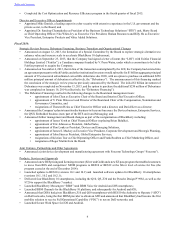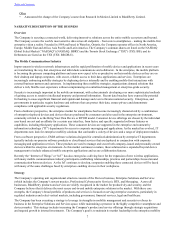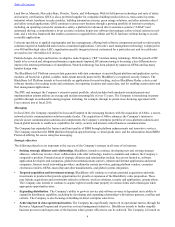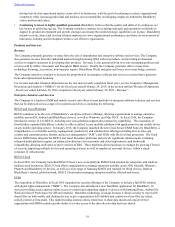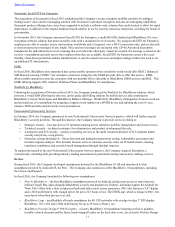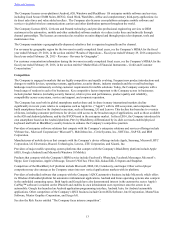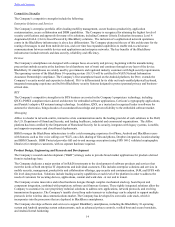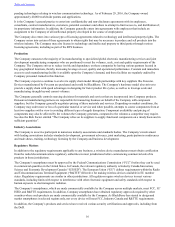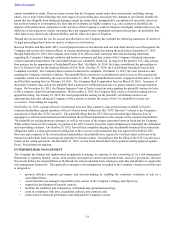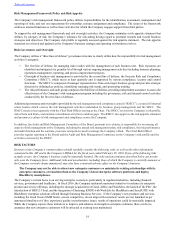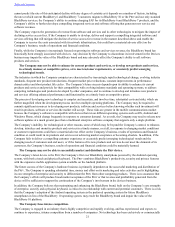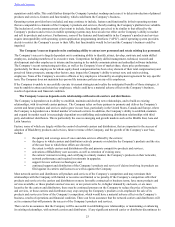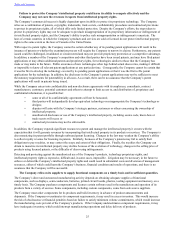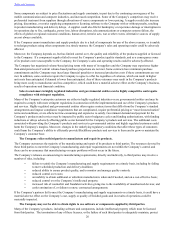Blackberry 2016 Annual Report Download - page 25
Download and view the complete annual report
Please find page 25 of the 2016 Blackberry annual report below. You can navigate through the pages in the report by either clicking on the pages listed below, or by using the keyword search tool below to find specific information within the annual report.
Table of Contents
16
pending technologies relating to wireless communication technology. As of February 29, 2016, the Company owned
approximately 40,000 worldwide patents and applications.
It is the Company’s general practice to enter into confidentiality and non-disclosure agreements with its employees,
consultants, contract manufacturers, customers, potential customers and others to attempt to limit access to, and distribution of,
its proprietary information. In addition, the Company generally enters into agreements with employees that include an
assignment to the Company of all intellectual property developed in the course of employment.
The Company also enters into various types of licensing agreements related to technology and intellectual property rights. The
Company enters into certain of these agreements to obtain rights that may be necessary to produce and sell products into the
wireless industry. The Company may also license its technology and intellectual property to third parties through various
licensing agreements, including as part of the BTS business.
Production
The Company outsources the majority of its manufacturing to specialized global electronic manufacturing services and joint
development manufacturing companies who are positioned to meet the volumes, scale, cost and quality requirements of the
Company. The Company strives to reduce its risk and dependency on these companies by having various partners located in
key geographical locations, thereby increasing leverage on cost, quality and operational performance. Constant and immediate
access to each manufacturing facility is available upon the Company’s demand, and these facilities are regularly audited by
Company personnel trained in this function.
The Company expects to continue to evolve its supply chain model through partnerships with key suppliers like Foxconn.
Devices manufactured by Foxconn are purchased and resold by BlackBerry. The Company’s hardware model also strives to
provide a supply chain with speed advantages in designing for faster product life cycles, as well as to leverage scale and
manufacturing strength beyond current volumes.
The Company generally controls sourcing decisions for materials and services that are incorporated into Company products.
Outsourced manufacturing partners are responsible for transacting business on behalf of the Company with component
suppliers, but the Company generally negotiates pricing of these materials and services. Depending on market conditions, the
Company may order more or less of a particular material or service and when possible, attempts to source components from at
least two suppliers with a view to avoiding different types of supply disruption. Component availability and pricing of
components may also be affected by the volumes the Company generates, compared to the volumes a competitor may require.
See also the Risk Factor entitled “The Company relies on its suppliers to supply functional components on a timely basis and in
sufficient quantities”.
Industry Associations
The Company is an active participant in numerous industry associations and standards bodies. The Company’s involvement
with leading associations includes standards development, government advocacy, joint marketing, participation in conferences
and trade shows, training, technology licensing by the Company and business development.
Regulatory Matters
In addition to the regulatory requirements applicable to any business, a wireless device manufacturer must obtain certification
from the radio/telecommunications regulatory authorities in most jurisdictions before commencing commercial sale of its
products in those jurisdictions.
The Company’s smartphones must be approved by the Federal Communications Commission (“FCC”) before they can be used
in commercial quantities in the United States. In Canada, the relevant regulatory authority is Industry Canada/Innovation,
Science and Economic Development Canada (“IC/ISED”). The European Union (“EU”) defines requirements within the Radio
and Telecommunications Terminal Equipment (“R&TTE”) Directive for making wireless devices available in EU member
states. Regulatory requirements are similar in other jurisdictions. All regulators require wireless devices to meet various
standards, including limits with respect to interference with other electronic equipment and safety standards with respect to
human exposure to electromagnetic radiation.
The Company’s smartphones, which are made commercially available by the Company across multiple markets, meet FCC, IC/
ISED, and R&TTE requirements. In addition, Company smartphones have obtained regulatory approvals required by other
countries where such products are made commercially available by the Company. As BlackBerry has started to design and
market smartphones in selected regions only, not every device will meet FCC, Industry Canada and R&TTE requirements.
In addition, the Company’s products and services have received various security certifications and approvals, including from
the DoD.


